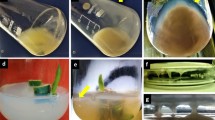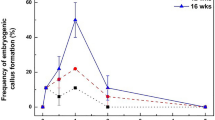Abstract
Maize may be transformed very efficiently using Agrobacterium tumefaciens-mediated methods. The most critical factor in the transformation protocol is the co-cultivation of healthy immature embryos of the correct developmental stage with A. tumefaciens; the embryos should be collected only from vigorous plants grown in well-conditioned glasshouses. With the protocol described here, approximately 50% of immature embryos from the inbred line A188 and 15% from inbred lines A634, H99 and W117 will produce transformants. About half of the transformed plants are expected to carry one or two copies of the transgenes, which are inherited by the progeny in a mendelian fashion. More than 90% of transformants are expected to be normal in morphology. The protocol takes about 3 months from the start of co-cultivation to the planting of transformants into pots.
This is a preview of subscription content, access via your institution
Access options
Subscribe to this journal
Receive 12 print issues and online access
$259.00 per year
only $21.58 per issue
Buy this article
- Purchase on SpringerLink
- Instant access to full article PDF
Prices may be subject to local taxes which are calculated during checkout






Similar content being viewed by others
References
Rhodes, C.A., Pierce, D.A., Mettler, I.J., Mascarenhas, D. & Detmer, J.J. Genetically transformed maize plants from protoplasts. Science 240, 204–207 (1988).
Gordon-Kamm, W. et al. Transformation of maize cells and regeneration of fertile transgenic plants. Plant Cell 2, 603–618 (1990).
Fromm, M.E. et al. Inheritance and expression of chimeric genes in the progeny of transgenic maize plants. Biotechnology 8, 833–839 (1990).
D'Halluin, K., Bonne, K., Bossut, M., De Beuckeleer, M. & Leemans, J. Transgenic maize plants by tissue electroporation. Plant Cell 4, 1495–1505 (1992).
Frame, B.R. et al. Production of fertile transgenic maize plants by silicon carbide whisker-mediated transformation. Plant J. 6, 941–948 (1994).
Koziel, M.G. et al. Field performance of elite transgenic maize plants expressing an insecticidal protein derived from Bacillus thuringiensis. Biotechnology 11, 194–200 (1993).
Armstrong, C. The first decade of maize transformation: a review and future perspective. Maydica 44, 101–109 (1999).
Register, J.C. III et al. Structure and function of selectable and non-selectable transgenes in maize after introduction by particle bombardment. Plant Mol. Biol. 25, 951–961 (1994).
Shou, H., Frame, B.A., Whitham, S.A. & Wang, K. Assessment of transgenic maize events produced by particle bombardment or Agrobacterium-mediated transformation. Mol. Breed. 13, 201–208 (2004).
Hiei, Y., Ohta, S., Komari, T. & Kumashiro, T. Efficient transformation of rice (Oryza sativa L.) mediated by Agrobacterium and sequence analysis of the boundaries of the T-DNA. Plant J. 6, 271–282 (1994).
Ishida, Y. et al. High efficiency transformation of maize (Zea mays L.) mediated by Agrobacterium tumefaciens. Nat. Biotechnol. 14, 745–750 (1996).
Cheng, M. et al. Genetic transformation of wheat mediated by Agrobacterium tumefaciens. Plant Physiol. 115, 971–980 (1997).
Tingay, S. et al. Agrobacterium tumefaciens-mediated barley transformation. Plant J. 11, 1369–1376 (1997).
Zhao, Z.-y. et al. Agrobacterium-mediated sorghum transformation. Plant Mol. Biol. 44, 789–798 (2000).
Negrotto, D., Jolley, M., Beer, S., Wenck, A.R. & Hansen, G. The use of phosphomannose-isomerase as a selectable marker to recover transgenic maize plants (Zea mays L.) via Agrobacterium transformation. Plant Cell Rep. 19, 798–803 (2000).
Nomura, M. et al. The evolution of C4 plants: acquisition of cis-regulatory sequences in the promoter of C4-type pyruvate, orthophosphate dikinase gene. Plant J. 22, 211–221 (2000).
Ohta, S., Ishida, Y. & Usami, S. Expression of cold-tolerant pyruvate, orthophosphate dikinase cDNA, and heterotetramer formation in transgenic maize plants. Transgenic Res. 13, 475–485 (2004).
Ohta, S., Ishida, Y. & Usami, S. High-level expression of cold-tolerant pyruvate, orthophosphate dikinase from a genomic clone with site-directed mutations in transgenic maize. Mol. Breed. 18, 29–38 (2006).
Taniguchi, M. et al. The promoter for the maize C4 pyruvate, orthophosphate dikinase gene directs cell- and tissue-specific transcription in transgenic maize plants. Plant Cell Physiol. 41, 42–48 (2000).
Ishida, Y., Saito, H., Hiei, Y. & Komari, T. Improved protocol for transformation of maize (Zea mays L.) mediated by Agrobacterium tumefaciens. Plant Biotechnol. 20, 57–66 (2003).
Hiei, Y., Ishida, Y., Kasaoka, K. & Komari, T. Improved frequency of transformation in rice and maize by treatment of immature embryos with centrifugation and heat prior to infection with Agrobacterium tumefaciens. Plant Cell Tissue Organ Cult. 87, 233–243 (2006).
Zhao, Z.-y. et al. High throughput genetic transformation mediated by Agrobacterium tumefaciens in maize. Mol. Breed. 8, 323–333 (2001).
De Block, M. et al. Engineering herbicide resistance in plants by expressing of a detoxifying enzyme. EMBO J. 6, 2513–2518 (1987).
van den Elzen, P.J.M., Townsend, J., Lee, K.Y. & Bedbrook, J.R. A chimaeric hygromycin resistance gene as a selectable marker in plant cells. Plant Mol. Biol. 5, 299–302 (1985).
Hood, E.E. et al. Restriction endonuclease map of pTiBo542, a potential Ti-plasmid vector for genetic engineering of plants. Biotechnology 2, 702–709 (1984).
Komari, T., Halperin, W. & Nester, E.W. Physical and functional map of supervirulent Agrobacterium tumefaciens tumor-inducing plasmid pTiBo542. J. Bacteriol. 166, 88–94 (1986).
Sheng, J. & Citovsky, V. Agrobacterium-plant cell DNA transport: have virulence proteins, will travel. Plant Cell 8, 1699–1710 (1996).
Armstrong, C.L., Green, C.E. & Phillips, R.L. Development and availability of germplasm with high type II culture formation response. Maize Genet. Coop. News Lett. 65, 92–93 (1991).
Frame, B.R. et al. Agrobacterium tumefaciens-mediated transformation of maize embryos using a standard binary vector system. Plant Physiol. 129, 13–22 (2002).
Huang, X. & Wei, Z. Successful Agrobacterium-mediated genetic transformation of maize elite inbred lines. Plant Cell Tissue Organ Cult. 83, 187–200 (2005).
Frame, B.R. et al. Improved Agrobacterium-mediated transformation of three maize inbred lines using MS salts. Plant Cell Rep. 25, 1024–1034 (2006).
Bajaj, Y.P.S. in Biotechnology in Agriculture and Forestry (ed. Bajaj, Y.P.S.) 3–23 (Springer-Verlag, Berlin, Heidelberg, 1994).
Frame, B.R., Paque, T. & Wang, K. in Methods in Molecular Biology (ed. Wang, K.) 185–199 (Humana Press Inc., Totowa, NJ, 2006).
Komari, T., Hiei, Y., Saito, Y., Murai, N. & Kumashiro, T. Vectors carrying two separate T-DNAs for co-transformation of higher plants mediated by Agrobacterium tumefaciens and segregation of transformants free from selection markers. Plant J. 10, 165–174 (1996).
Linsmaier, E. & Skoog, F. Organic growth factor requirements of tobacco tissue culture. Physiol. Plant 18, 100–127 (1965).
Wang, M.-B. & Waterhouse, P.M. A rapid and simple method of assaying plants transformed with hygromycin and PPT resistance genes. Plant Mol. Biol. Rep. 15, 209–215 (1997).
Miller, M. et al. High efficiency transgene segregation in co-transformation maize plants using an Agrobacterium tumefaciens 2 T-DNA binary system. Transgenic Res. 11, 381–396 (2002).
Ishida, Y. et al. Improved co-transformation of maize with vectors carrying two separate T-DNAs mediated by Agrobacterium tumefaciens. Plant Biotechnol. 21, 57–63 (2004).
Hiei, Y. & Komari, T. Improved protocols for transformation of indica rice mediated by Agrobacterium tumefaciens. Plant Cell Tissue Organ Cult. 85, 271–283 (2006).
Ohta, S., Mita, S., Hattori, T. & Nakamura, K. Construction and expression in tobacco of a β-glucuronidase (GUS) reporter gene containing an intron within the coding sequence. Plant Cell Physiol. 31, 805–813 (1990).
Jefferson, R.A. Assaying chimeric genes in plants: the GUS gene fusion system. Plant Mol. Biol. Rep. 5, 387–405 (1987).
Acknowledgements
We thank Ms. E. Usami and Ms. M. Noguchi for skillful assistance.
Author information
Authors and Affiliations
Corresponding author
Ethics declarations
Competing interests
The authors declare no competing financial interests.
Rights and permissions
About this article
Cite this article
Ishida, Y., Hiei, Y. & Komari, T. Agrobacterium-mediated transformation of maize. Nat Protoc 2, 1614–1621 (2007). https://doi.org/10.1038/nprot.2007.241
Published:
Issue date:
DOI: https://doi.org/10.1038/nprot.2007.241
This article is cited by
-
Plant regeneration in the new era: from molecular mechanisms to biotechnology applications
Science China Life Sciences (2024)
-
Transcriptome-wide identification and characterization of genes exhibit allele-specific imprinting in maize embryo and endosperm
BMC Plant Biology (2023)
-
A transcription factor ZmGLK36 confers broad resistance to maize rough dwarf disease in cereal crops
Nature Plants (2023)
-
Efficient Agrobacterium tumefaciens-mediated genetic transformation of Aloe vera
Plant Cell, Tissue and Organ Culture (PCTOC) (2023)
-
Modern plant biotechnology as a strategy in addressing climate change and attaining food security
Agriculture & Food Security (2022)



